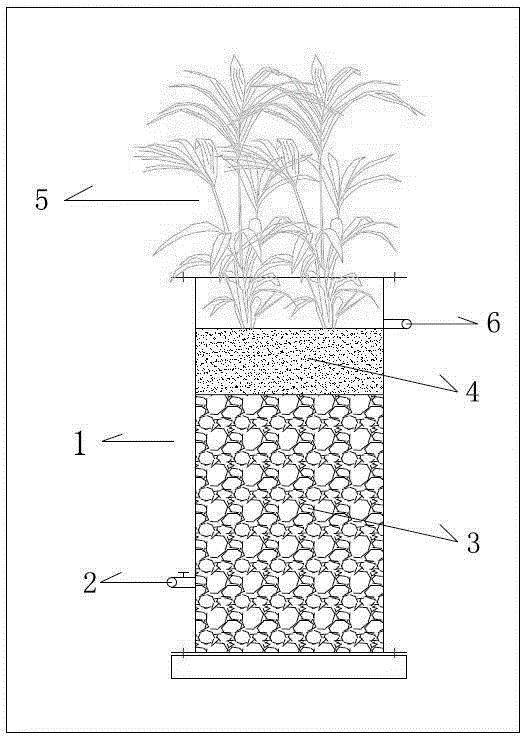Upwelling artificial wetland for removing nitrogen, phosphorus and antibiotics in aquaculture wastewater
A technology for artificial wetlands and aquaculture wastewater, applied in sustainable biological treatment, chemical instruments and methods, biological water/sewage treatment, etc. The effect of hydraulic retention time, complete adsorption or decomposition, and avoidance of hydraulic dead zone
- Summary
- Abstract
- Description
- Claims
- Application Information
AI Technical Summary
Problems solved by technology
Method used
Image
Examples
specific Embodiment approach 1
[0019] Embodiment 1: The present invention adopts the vertical flow constructed wetland mode, and the system packing layer includes an upper layer and a lower layer, the upper layer is the red soil in Fujian area selected for the red soil layer (4), and the lower layer is the oyster shell-waste brick mixed packing layer ( 3), in which oyster shells are by-products of coastal farming and fishing in Fujian, the volume ratio of oyster shells and waste bricks is about 1:1, and the particle size range: 10-30 mm. The red soil layer (4) is planted with reeds (5). The reeds have high growth density, developed root systems and are closely combined with the filler layer.
specific Embodiment approach 2
[0020] Specific embodiment 2: The present invention adopts an upflow process, and a water inlet pipe (2) is arranged at the bottom of the constructed wetland system (1), and the bottom enters the water, first through the mixed packing layer (3), and then through the red soil layer (4) and The plant growth layer (5) is finally discharged from the water outlet pipe (6).
specific Embodiment approach 3
[0021] Embodiment 3: When the hydraulic load is set to 0.02 - 0.1 m 3 / (m 2 d), the device of the present invention can meet the requirement of simultaneous treatment of nitrogen, phosphorus and antibiotics.
[0022] Embodiment 4: Set the antibiotic concentration at 300 μg L -1 Hereinafter, the device of the present invention can meet the requirement of simultaneous removal of nitrogen, phosphorus and antibiotics.
[0023] Embodiment 5: For the wetland plant reed, according to seasonal changes, harvest once from March to May, twice from June to August, once from September to November, and not harvested from December to February.
[0024] The present invention will be described in further detail below by means of examples.
PUM
| Property | Measurement | Unit |
|---|---|---|
| particle diameter | aaaaa | aaaaa |
| particle diameter | aaaaa | aaaaa |
Abstract
Description
Claims
Application Information
 Login to View More
Login to View More - R&D
- Intellectual Property
- Life Sciences
- Materials
- Tech Scout
- Unparalleled Data Quality
- Higher Quality Content
- 60% Fewer Hallucinations
Browse by: Latest US Patents, China's latest patents, Technical Efficacy Thesaurus, Application Domain, Technology Topic, Popular Technical Reports.
© 2025 PatSnap. All rights reserved.Legal|Privacy policy|Modern Slavery Act Transparency Statement|Sitemap|About US| Contact US: help@patsnap.com

